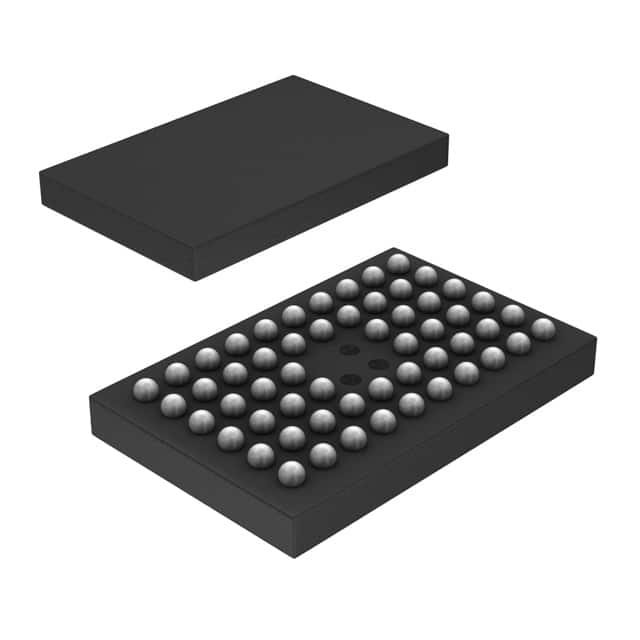Viz Specifikace pro podrobnosti o produktu.

SN74LVT16245BGQLR
Basic Information Overview
- Category: Integrated Circuit (IC)
- Use: Level Shifting and Bus Transceiver
- Characteristics: High-speed, Low-voltage, Bi-directional
- Package: 48-pin BGA (Ball Grid Array)
- Essence: Transceiver IC for voltage level translation between different logic families
- Packaging/Quantity: Tape and Reel, 2500 units per reel
Specifications
- Supply Voltage Range: 1.65V to 3.6V
- Logic Family: LVT (Low-Voltage TTL)
- Number of Channels: 16
- Input/Output Type: Tri-state
- Maximum Data Rate: 400 Mbps
- Operating Temperature Range: -40°C to +85°C
Detailed Pin Configuration
The SN74LVT16245BGQLR has a total of 48 pins, which are divided into four groups of 12 pins each. The pin configuration is as follows:
Group A (Pins 1-12)
- Pin 1: OE (Output Enable) 1
- Pin 2: A1 (Data Input/Output) 1
- Pin 3: A2 (Data Input/Output) 1
- ...
- Pin 12: GND (Ground)
Group B (Pins 13-24)
- Pin 13: VCC (Power Supply)
- Pin 14: B1 (Data Input/Output) 1
- Pin 15: B2 (Data Input/Output) 1
- ...
- Pin 24: GND (Ground)
Group C (Pins 25-36)
- Pin 25: OE (Output Enable) 2
- Pin 26: A1 (Data Input/Output) 2
- Pin 27: A2 (Data Input/Output) 2
- ...
- Pin 36: GND (Ground)
Group D (Pins 37-48)
- Pin 37: VCC (Power Supply)
- Pin 38: B1 (Data Input/Output) 2
- Pin 39: B2 (Data Input/Output) 2
- ...
- Pin 48: GND (Ground)
Functional Features
- Bi-directional voltage level translation between two logic families
- Tri-state outputs for bus sharing and isolation
- High-speed operation with low propagation delay
- ESD (Electrostatic Discharge) protection on all inputs and outputs
Advantages and Disadvantages
Advantages
- Wide supply voltage range allows compatibility with various systems
- Bi-directional capability simplifies interface design
- Tri-state outputs enable efficient bus sharing
- High-speed operation enhances system performance
- ESD protection ensures reliability in harsh environments
Disadvantages
- Limited to 16 channels, may not be suitable for applications requiring more channels
- Requires careful consideration of input/output voltage levels to prevent signal distortion
Working Principles
The SN74LVT16245BGQLR is designed to translate voltage levels between two different logic families. It operates by receiving data from one side and transmitting it to the other side while maintaining proper voltage levels. The direction of data flow is controlled by the Output Enable (OE) pins. When the OE pin is high, the device is in the active state, allowing data transmission. When the OE pin is low, the device is in the tri-state state, isolating the bus and preventing data interference.
Detailed Application Field Plans
The SN74LVT16245BGQLR is commonly used in various applications that require voltage level translation and bus transceiver functionality. Some specific application fields include: - Microcontroller interfacing with different logic families - Communication systems involving multiple voltage domains - Data acquisition and processing systems - Industrial automation and control systems - Automotive electronics
Detailed and Complete Alternative Models
- SN74LVC16245A: Similar functionality, but operates at a lower voltage range (1.65V to 3.6V)
- SN74LVTH16245: Bi-directional level shifter with 3-state outputs and higher data rate capability
- SN74AVC4T245: Quad-channel level translator with integrated voltage level shifting and bus transceiver functionality
These alternative models offer similar features and can be considered based on specific application requirements.
Word count: 509 words
Seznam 10 běžných otázek a odpovědí souvisejících s aplikací SN74LVT16245BGQLR v technických řešeních
Sure! Here are 10 common questions and answers related to the application of SN74LVT16245BGQLR in technical solutions:
Q: What is the SN74LVT16245BGQLR? A: The SN74LVT16245BGQLR is a 16-bit bus transceiver with 3-state outputs, designed for low-voltage (3.3V) applications.
Q: What is the purpose of the SN74LVT16245BGQLR? A: The SN74LVT16245BGQLR is used to enable bidirectional data transfer between two buses with different voltage levels.
Q: What is the maximum operating frequency of the SN74LVT16245BGQLR? A: The SN74LVT16245BGQLR can operate at frequencies up to 200 MHz.
Q: What is the voltage range supported by the SN74LVT16245BGQLR? A: The SN74LVT16245BGQLR supports a voltage range from 2.7V to 3.6V.
Q: Can the SN74LVT16245BGQLR be used in both input and output modes? A: Yes, the SN74LVT16245BGQLR can be used as both an input and output buffer.
Q: How many channels does the SN74LVT16245BGQLR have? A: The SN74LVT16245BGQLR has 16 bidirectional channels.
Q: Does the SN74LVT16245BGQLR support hot insertion? A: Yes, the SN74LVT16245BGQLR is designed to support hot insertion.
Q: What is the output drive strength of the SN74LVT16245BGQLR? A: The SN74LVT16245BGQLR has a typical output drive strength of ±12 mA.
Q: Can the SN74LVT16245BGQLR be used in mixed-voltage systems? A: Yes, the SN74LVT16245BGQLR is suitable for use in mixed-voltage systems.
Q: What is the package type of the SN74LVT16245BGQLR? A: The SN74LVT16245BGQLR comes in a 48-pin BGA (Ball Grid Array) package.
Please note that these answers are general and may vary depending on the specific application and requirements.

